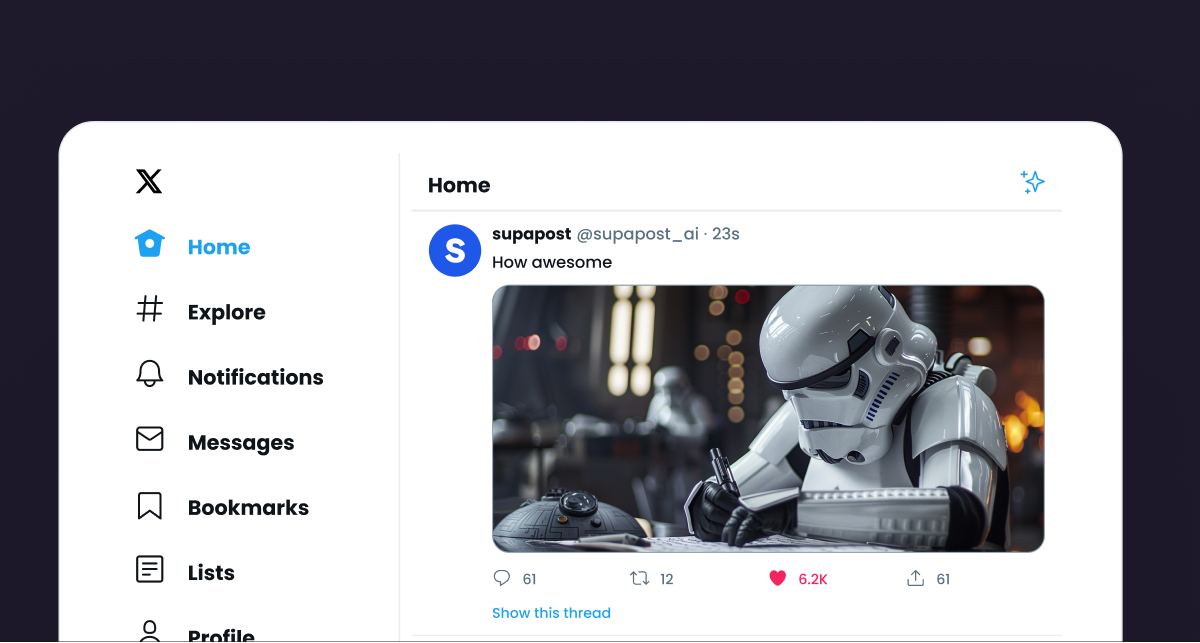x (Twitter) post dimensions guide 2024 + Figma resources Written on . Posted in Best practices.

We’ve all been there—uploading what we think is the perfect image to X (formerly Twitter), only to find it awkwardly cropped or pixelated once it’s posted. Frustrating, right? Getting the image size right on social media can feel like a guessing game, but when done correctly, it’s a game-changer. Following the right image sizes can help you avoid poor-quality visuals, awkward cropping, and, most importantly, keep your followers engaged. When your visuals are sharp and sized correctly, they’re more likely to get shared, liked, and retweeted. In this guide, we'll cover the ideal Twitter post dimensions, Twitter card sizes, and best practices for optimizing your visuals in 2024.

1. X (Twitter) Post Dimensions
When sharing images on X (Twitter), following the recommended dimensions ensures that your content looks polished and clear across all devices. Incorrect sizes can result in poor quality, awkward cropping, and missed engagement opportunities.
- Recommended Size for Single Image Posts: 1600 x 900 pixels (16:9 aspect ratio)
- Minimum Size: 1024 x 512 pixels
- Maximum File Size: 5 MB for images
Following these dimensions guarantees your images are displayed correctly on both desktop and mobile without losing quality. If you’re scheduling your posts ahead of time, make sure you’re using the right size to avoid image issues down the line. For tips on planning your content, check out our guide on how to schedule X/Twitter posts.
Multi-Image Posts:
Multi-image tweets allow you to share up to four images in a single post, each displayed differently based on how many are attached. Here are the best practices:
- Two images: Displayed side by side. Use 1200 x 675 pixels for each image.
- Three images: The first image appears larger, with the two smaller images beneath it. Aim for 1200 x 675 pixels per image.
- Four images: Displayed in a grid, with each image sized at 1200 x 675 pixels.
These sizes ensure that your multi-image posts remain visually appealing without distortion. Learn more about improving your engagement through smart visual strategies in our guide to X/Twitter image dimensions.
2. Aspect Ratios: The Key to Image Quality
Aspect ratios define the relationship between the width and height of an image. Using the right aspect ratio prevents unwanted cropping, especially on mobile devices. The most commonly used ratio for Twitter images is 16:9 for landscape images. However, other ratios can also be effective:
- 16:9: The standard for landscape images.
- 1:1: Perfect for square images, typically used across platforms like Instagram. This is great for repurposing content.
- 4:5: Ideal for vertical images when you want to take up more screen space in users' feeds.
3. Twitter Photo Specs
Uploading images that meet the recommended Twitter photo specs is essential for keeping your visuals sharp and engaging. Twitter compresses images when uploading, so starting with a high-resolution file is crucial to maintaining quality. Here’s a quick breakdown:
- Single Image: 1600 x 900 pixels (16:9 aspect ratio)
- Square Image: 1080 x 1080 pixels (1:1 aspect ratio)
- Vertical Image: 1080 x 1350 pixels (4:5 aspect ratio)
Following these guidelines ensures that your content looks professional and appealing across devices. To learn more about capturing attention with visuals, check out our article on hooks for X/Twitter posts.
4. Optimizing Vertical Image Sizes on X (Twitter)
Vertical images take up more space in the feed, making them more likely to grab attention as users scroll. The recommended vertical image size is 1080 x 1350 pixels, with a 4:5 aspect ratio. This size ensures your image appears correctly on both desktop and mobile without being cropped.
Why use vertical images?
- Better Engagement: Vertical images capture more space on the screen, drawing the viewer’s attention.
- Clearer Display: Following the 1080 x 1350 pixels size ensures your image won’t be automatically cropped by Twitter.
5. X (Twitter) Card Sizes
Twitter cards are a valuable feature for sharing links or running ads with rich visual previews. By following the correct card sizes, you can ensure your content looks great, attracts clicks, and engages users. Here are the recommended (X) Twitter card sizes:
- Website Card: 800 x 418 pixels (1.91:1 aspect ratio). This card is used for promoting external websites with a clickable image that draws users to the linked page.
- App Card: 800 x 800 pixels (1:1 aspect ratio). App cards are perfect for showcasing mobile apps and providing a direct download link.
- Video Card: 1200 x 1200 pixels (1:1 aspect ratio). These are ideal for promoting video content directly in the feed.
Using the correct dimensions for your X (Twitter) cards ensures a seamless and visually appealing presentation of your content. This is especially important when running ad campaigns, as improperly sized images can negatively affect your click-through rates. Learn more about optimizing your tweets in our X/Twitter analytics guide.
6. Figma Resources for Designing X (Twitter) Images
Designing visuals that fit Twitter’s size guidelines can be made easy using tools like Figma. Here are a few useful Figma resources that help you create Twitter-optimized images quickly and easily:
- Twitter Post Template: This template includes the correct dimensions for single and multi-image posts, ensuring your visuals are always perfectly sized.
- Multi-Image Tweet Template: Perfect for creating clean, visually engaging multi-image tweets.
- Social Media Aspect Ratio Guide: This guide helps you maintain the correct aspect ratios across different social media platforms, making it easy to repurpose content.
Final Thoughts
Ensuring your X (Twitter) post dimensions are correct is crucial for maximizing the impact of your visuals. Whether you're posting single images, multi-image tweets, or using X (Twitter) cards for promotion, following the recommended sizes ensures your content looks polished and professional. Use tools like Figma to streamline your design process, and always preview your posts before going live to ensure they display correctly on both desktop and mobile.
To take your X (Twitter) strategy to the next level, be sure to explore our other articles on creating viral content and building a personal brand on X.
